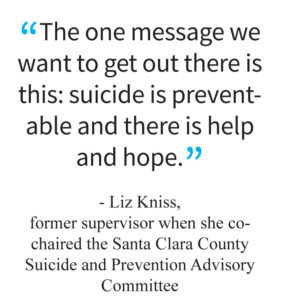Editorial – County, cities and media working to prevent suicides
Published in the April 18 – May 1, 2018 issue of Gilroy Life
 Death by suicide can put family, friends, loved ones, coworkers and neighbors in a state of shock from the tragedy and suffer long-lasting grief. It is the leading cause of death by injury in Santa Clara County. More people die by suicide than homicide in the county.
Death by suicide can put family, friends, loved ones, coworkers and neighbors in a state of shock from the tragedy and suffer long-lasting grief. It is the leading cause of death by injury in Santa Clara County. More people die by suicide than homicide in the county.
According to a report released last year by the Centers for Disease Control and Prevention, Palo Alto and Morgan Hill have the highest suicide rates in Santa Clara County among youths 10 to 24. From 2003 to 2015, Palo Alto’s youth suicide rate per 100,000 people was 14.1. Morgan Hill was 12.7, according to the CDC’s report. Both cities saw much higher rates than the county rate of 5.4 deaths per 100,000. The CDC’s study also found that suicides are more common among males and youths 20 to 24 years old. Suicide is the 10th leading cause of death in Santa Clara County.
But in the public forum on the issue of suicide, the discussions need to go beyond the statistics. A suicidal death has a ripple effect, impacting the people and community beyond the individual whose life was lost. And it also emotionally impacts the first-responders who must deal with the aftermath.
To reduce the rate of suicides in the county, in 2010 the Santa Clara County Suicide Prevention Advisory Committee unveiled the county’s first comprehensive suicide prevention strategic plan to the Board of Supervisors. The plan serves as a springboard for a community-wide effort to provide the resources and awareness needed to reduce the suicide rate in Santa Clara County. It was developed by professionals in fields including law enforcement, addiction experts, school officials, and policy makers, as well as suicide attempt survivors and family members who have lost a loved one to suicide.
Experts studied available data on suicide deaths for county, state and nation. They identified needs by age, risk populations, and potential strategies. They developed and organized recommendations into five strategies:
- Implementing suicide intervention programs and services for targeted high-risk populations.
- Implementing a community education and information campaign to increase public awareness.
- Developing local communication “best practices” to improve media coverage and public dialogue related to suicide.
- Implementing policy and governance advocacy to promote systems change in suicide awareness and prevention.
- Establishing a data collection and monitoring system to increase the scope and availability of suicide-related data and to evaluate prevention efforts.
“The one message we want to get out there is this: suicide is preventable, there is help and hope,” said former Supervisor Liz Kniss when she co-chaired the Santa Clara County Suicide and Prevention Advisory Committee in developing the plan. “Every day, we hear about how to prevent heart disease, but we don’t hear how to prevent suicide. Our Suicide Prevention Strategic Plan is the first step in a community call to action.”
We at Gilroy Life attended a March 12 briefing organized by professionals with the Santa Clara County Behavioral Health Services Department to learn about the county’s activities in suicide prevention as well as discuss the role of journalists and the media in preventing suicides. The county has initiated training for educators, healthcare professionals, first-responders and professionals in other agencies to help them see the warning signs of someone considering suicide and know how best to help the person.
Elected officials in Gilroy and Morgan Hill are aware of the prevention work being done in the county. The Morgan Hill City Council recently unanimously approved a suicide prevention policy. The city of Gilroy is now working on a similar policy for its residents.
“It’s important to understand as we look at this that South County leaders are committed to addressing suicide in our community,” said Morgan Hill Police Chief David Swing at the briefing. “It’s a holistic leadership approach and includes many different groups.”
An important part of the initiative is “safe messaging” of how to find help for depression and suicidal thoughts as well as strengthening the mental health services, he said.
“The goal of the suicide prevention policy is to build resiliency,” Swing said. “It demonstrates the commitment and it demonstrates our goal of building resiliency so when those who are away from their support system and from their families, they have the strength to deal with life’s stressors.”
Gilroy Life understands that what we publish and the tone in which we report a story about a sensitive subject such as suicide can have a deep impact on individuals. We have a policy that if a private person died by suicide, we will not include that detail of death in the story or obituary. This is to respect the family and friends. If a public person such as an elected official, however, took his or her life, we more than likely will include that information in a story because it has relevance to the community conversation. But we will do so with dignity and respect.
We encourage anyone who feels hopeless or emotionally despondent enough to consider taking his or her own life to remember that there are people who want to help them get through their days of darkness. Give yourself the gift of tomorrow.
- Editorial: Valley Water takes action against director’s misconduct - April 17, 2024
- Editorial: Prop 1 passes, addresses unhoused and mental health - April 5, 2024
- Editorial: Stay vigilant of online disinformation during election year - March 22, 2024
